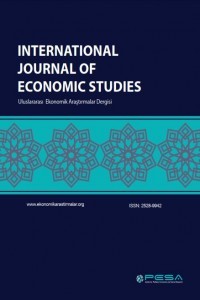Mükelleflerin Kayıtdışı Ekonomiye Yönlenme Nedenleri: Ostim Organize Sanayi Örneği
Bu çalışmanın amacı, Türkiye’nin en büyük organize sanayi bölgesi olan OSTİM’de (Ortadoğu Sanayi ve Ticaret Merkezi) kayıtdışı faaliyetleri oluşturan nedenleri açıklamaktır. Çalışmada Ostim’deki vergi mükelleflerinin, kayıtdışı ekonomiye yönlenme nedenleri anket uygulaması ile ölçülmeye çalışılmıştır. Anket güvenilirliği için Croncbach’s Alpha katsayısı ile değerlendirilme yapılmıştır. Bu katsayı uygulanan anket için kabul edilebilir aralığı veren 0,70’dir. Çalışmanın iddiası; Vergi mükelleflerinin vergi oranlarını yüksek bulmalarıyla vergi kaçırmaları arasında bir paralellik bulunacağı, vergi denetimlerini düşük bulan mükelleflerin vergi denetimlerinin sıklaşmasıyla kayıtdışının azalacağını düşüneceği, vergi ahlak ve bilincinin ve mükelleflerin sosyo-demografik özelliklerinin kayıtdışı ekonomi oluşturma üzerinde etkisi olduğu yönündedir.
Anahtar Kelimeler:
Kayıtdışı Ekonomi, Vergi Kaçırma, Vergi Mükellefi
The Reasons Behind the Tax Payer’s Preferences for Shadow Economy (a Case Study Conducted in Ostim Industrial Zone)
The aim of this study is to identify the reasons behind the activities of shadow economy at OSTIM (Industrial Zone and Trade Centre of Middle East), the greatest industrial zone in Turkey, In this study, we tried to come up with sound criteria as to what tax payers doing business in the industrial area of Ostim think of the real reasons paving the way for shadow economy. There liability of questionnaire is tested by the coefficient Cronbach’s alpha. This coefficient is 0.70 which indicates that the research tool is reliable. The argument that this study raises is that there is a correlation between the reason they find extremely tax rates high and why they resort to tax evasion as a result, and that tax payers who have the notion that frequency of tax audits is lower than expected assume that the volume of shadow economy will decrease provided that tax audits are conducted as often as necessary, and moreover socio-demographic factors and taxpayers morale and concious have an impact upon the shadow economy developed over the years in the area concerned
Keywords:
Shadow Economy, Tax Evasion, Tax Payers,
___
- Acar, Fatih ve Aydın Fazıl (2014), Vergi ve İstihdam Politikaları Açısından Kayıt Dışı Ekonomi, Ankara: TODAİE, 1. Basım, s.5.
- Allingham, Michael, G.ve Sandmo, Agnar, (1972), “Income Tax Evasion: A Therotical Analysis”, Journal Of Public Economics, p.322 – 328.
- Altuğ, Osman (1999), “Kayıtdışı Ekonominin Boyutları”, Erciyes Üniversitesi İİBF Dergisi, 15, s.257.
- Aydemir, Şinasi (1995), Türkiye’de Kayıtdışı Ekonomi, İstanbul: Seçkin Yayıncılık, 1.Baskı, s.63.
- Cagan, Philip (1958), “The Demand for Currency Relative to the Total Money Supply,” Journal.
- Çelikkaya, Ali ve Gürbüz, Hüseyin (2008), “Mükelleflerin Vergiye Karşı Tutum ve Davranışlarını Etkileyen Çeşitli Değişkenler Arasındaki İlişkinin Analizi”, Sosyoekonomi, 2.
- Çetintaş, Hakan (2003), “Türkiye’de Kayıtdışılığın Fayda Maliyet Analizi”, Çimento İşveren Dergisi, Sayı 17, s.4.
- Çetintaş, Hakan ve Vergil, Hasan (2003), “Türkiye’de Kayıtdışı Ekonomi”, Doğuş Üniversitesi Dergisi, Sayı:4, Cilt:1, s.17.
- Çomaklı, Şafak, E. (2007), Türkiye’de Kayıtdışı Ekonomi ve Vergisel Kayıtdışılık, Erzurum: Turhan Kitabevi.
- Demir, İhsan, C. ve Küçükilhan, Mustafa (2013), “Vergi Mükelleflerinin Kayıtdışı Algısı: Türkiye Üzerine Ampirik Bir Çalışma”, Ekonomik ve Sosyal Araştırmalar Dergisi, Cilt:9, Yıl:9, Sayı:1, 9:32 – 48.
- Devlet Planlama Teşkilatı (2001), Sekizinci Beş Yıllık Kalkınma Planı Kayıt Dışı Ekonomi Özel İhtisas Komisyonu Raporu, s.5.
- Derdiyok, Türkmen (1993), “Türkiye’nin Kayıtdışı Ekonomisinin Tahmini,” Türkiye İktisat, Mayıs, TOBB Yayını, S.13, s. 54
- Dumlupınar, Serdar ve Yardımcıoğlu, Fatih (2015), “Vergi Denetimlerinin Kayıt dışı Ekonomi Üzerine Etkisi: Trabzon İli Örneği”, Maliye Araştırmaları Dergisi, Yıl:1, Cilt:1, Sayı:1.
- Gökbunar, Rıza A. (1995), “Kayıtdışı Ekonominin Vergilendirilmesine Yönelik Önlemler”, Maliye Yazıları, Sayı:47, Ekim – Aralık 1995, s.83.
- Gutmann, Peter M. (1977), “The Subterranean Economy”, Financial Analyst Journal, p.26.
- Feige, Edgar L. (1990), “Defining and Estimating Underground and Informal Economies: The New Institutional Economcs Approach”, World Development, Vol.18, No.7.
- Feld, Lars, P. and Frey, Bruno. S. (2002), “Trust breeds trust: How taxpayers are treated”, Economics of Governance, 3, p.87–99
- Hofstede, Geert, H., (1980), Cultures consequences: International differences in work-related values. In Beverly Hills. CA: Sage Publications, p. 294
- Hofstede, Geert, H. (2001), Cultures consequences: Comparing values, behaviors, institutions and organizations across nations (2nd ed.). London: Sage Publications. Hofstede, G. H., & Bond, M. H. (1988). The Confucius connection: From cultural roots to economic growth. Organizational Dynamics, 5–21, p.319 – 321.
- Husted, Byan, W., (1999), Wealth, culture, and corruption. Journal of International Business Studies, 30, p.339–359
- Jackson, BR., and Milliron, VC. (1986), “Tax Compliance research: Findings, problems and prospects”, Journal of Accounting Literature, p.127
- Levi, Margaret, (1998), “A State of trust”, Trust and governance, New York, NY: Russell Sage Foundation, p.77–101
- McCrohan, Kevin, F. ve Smith, James, D. (1986), “a Consumer Expenditure Approach to Estimating the Size of the Underground Economy, Journal of Marketing, v.50, No:2, p.49
- Muter, Naci, Çelebi, A. Kemal ve Sakıç, Süreyya (1993), Mükelleflerin Vergi Karşısındaki Tutum ve Davranışların Araştırılması: Manisa.
- Ostim Organize Sanayi Bölgesi, Ostim Küçük Sanayi Sitesi Yapı Kooperatifi, http://ostim.org.tr/get/Kurumsal/Tarih%C3%A7e, 10.06.2016
- Özdamar, Kazım (2004), Paket Programlar ile İstatiksel Veri Analizi –1, Genişletilmiş 5.Baskı, Kaan Kitabevi, Eskişehir, s.633.
- Özsoylu, Ahmet, F. (1996), Türkiye’de Kayıtdışı Ekonomi, İstanbul: Bağlam Yayıncılık, s.46.
- Richardson, Grant (2006),“Determinants Of Tax Evasion: A Cross - Country Investigation”, Journal Of İnternational Accounting Auditing&Taxation, 15, p.150-169.
- Schneider, Friedrich, (1986), “Estimating the Size of the Danish Shadow Economy Using the Currency Demand Approach: An Attempt”,Scandinavian Journal of Economics, 88 (4).
- Synthèse,(2014), Rencontre economiques, l’economie souterraine en temps de crise, http://www.economie.gouv.fr/files/rencontres_economiques_synthese_23092014.pdf
- Tsakumis, George, T.; Curatola, Anthony, P. and Porcano, Thomas, M. (2007), “The relation between national cultural dimensions and tax evasion”, Journal of International Accounting, Auditing and Taxation, 16, p.131–147.
- Tuay, Elif ve Gülay, İnci, (2007), Türkiye’de Vergi Mükelleflerinin Vergiye Bakışı, Gelir İdaresi Başkanlığı, Mükellef Hizmetleri Daire Başkanlığı, Yayın No: 51, s.28.
- ISSN: 2528-9942
- Başlangıç: 2015
- Yayıncı: Politik Ekonomik ve Sosyal Araştırmalar Merkezi
Sayıdaki Diğer Makaleler
İthalatın Ekonomik Büyüme Üzerindeki Doğrudan ve Dolaylı Etkileri: Feder-Ram Modeli
Vergilemede Fayda İlkesi Bağlamında Sosyal Güvenlik Primlerine Bakış: Türkiye Örneği
Mükelleflerin Kayıtdışı Ekonomiye Yönlenme Nedenleri: Ostim Organize Sanayi Örneği
Yüksel BAYRAKTAR, Halil İbrahim KAYA
Yusuf BAYRAKTUTAN, Meltem TARI ÖZGÜR
Birleşik Üretimlerde Yeni Bir Yaklaşımla Madde Maliyeti Hesaplama Algoritması
